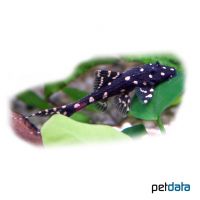Adonis Pleco (Acanthicus adonis)
| Adonis Pleco Acanthicus adonis | |
|---|---|
| Name | Adonis Pleco |
| Name Lat. | Acanthicus adonis |
| Family | Suckermouth Armoured Catfishes |
| Family lat. | Loricariidae |
| Order | Catfishes |
| Order lat. | Siluriformes |
| Origin | Brazil |
| Habitat | Rivers |
| Diet | Omnivore, soft wood |
| pH | 5.5-7.5 |
| Behavior | Nocturnal, peaceful |
| Keeping | Individual, pair, group |
| Care Level | Experts only |
| Reproduction | Cave spawner |
| Breeding | None reported |
| Life Span | 15-20 years |
| Protection | No |
| Metric Units | |
| Size | 70 cm |
| Temperature | 22-27 °C |
| Hardness | 2-12 °dH |
| Aquarium | ~ 1,000 l |
| US Units | |
| Size | 28" |
| Temperature | 72-81 °F |
| Hardness | 36-214 ppm |
| Aquarium | ~ 260 gal |
Distribution and habitat
The distribution area of the Beautiful Elf Catfish is the catchment area of the Rio Tocantins near Cametá in Pará (Brazil). They mainly stay in shallow water with dead wood.
Maintenance
The aquarium should have robust planting, with large roots that provide hiding places and are a component of their diet. Plenty of free swimming space, subdued light and a current are ideal
No ammonia, ammonium or nitrite should be detectable, and nitrate levels should not exceed 100 mg/l. To ensure the water quality and oxygen content, a filter and heater adapted to the aquarium size is required, as well as lighting for the species-appropriate day-night rhythm of the animals.
Diet
They feed on plant and animal food. For a balanced diet, feed once a day with a high-quality dry food for loricariid catfish (granules, pellets, chips, tablets), supplemented with algae leaves, soft wood and fresh vegetables, such as zucchini, broccoli, bruised peas, scalded spinach, as well as zoopankton, cyclops, daphnia, artemia, mosquito larvae, shrimp, etc. (live or frozen)
Feed only as much as will be eaten within a few minutes, excluding plant foods. Regular and varied feeding promotes health and increases resistance.
Behaviour and compatibility
Beautiful elf catfishes are crepuscular to nocturnal and behave very territorial within the species, therefore several animals should only be kept in very large and richly structured tanks. Towards other, not too small fish, they are usually peaceful and can be socialized well with them.
Basically, only compatible fish species with similar demands on water quality and water temperature may be socialized.
Sex dimorphism
Sexually mature males have a blunter genital papilla and more powerful pectoral spines (on the first pectoral fin ray) than females.
Reproduction and breeding
There are isolated reports of successful breeding in the aquarium. They are cave breeders and the male takes over the brood care.
Important
They have a strong sucking mouth, with spoon-shaped teeth for scraping wood, and intestinal flora that allows the fish to digest the cellulose.
When fishing, use the finest mesh nets possible to prevent the hard rays of the pectoral fins or the skin teeth (odontodes) from getting caught on the bone plates, which can cause painful puncture wounds when touched.
The well-being of the fish should be checked regularly. Temperature should be checked daily, pH, hardness and nitrate levels at least every 14 days. Regular partial water changes are recommended, even when contaminant levels have not yet reached the upper limit. Sudden changes in water quality should be avoided. Newly introduced fish must be accustomed slowly to the water in the aquarium.
Further literature can be found in your pet store.
References
Text: Werner Winter; Image: petdata
Source: BMELV (1998): Tierschutzgutachten - Haltung von Zierfischen (Süßwasser); RIEHL & BAENSCH (2004): Aquarien Atlas Bd. 3, Mergus Verlag; SCHMIDT, WERNER, LECHNER (2005): MiniAtlas L-Welse, Bede Verlag
- Gemäß § 21 Abs. 5 Tierschutzgesetz idgF
